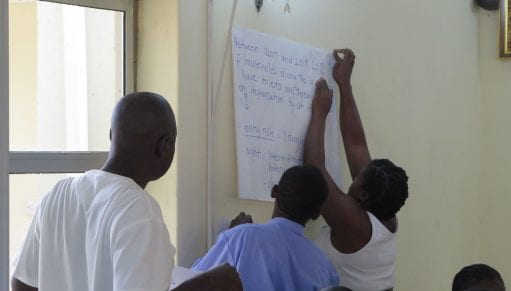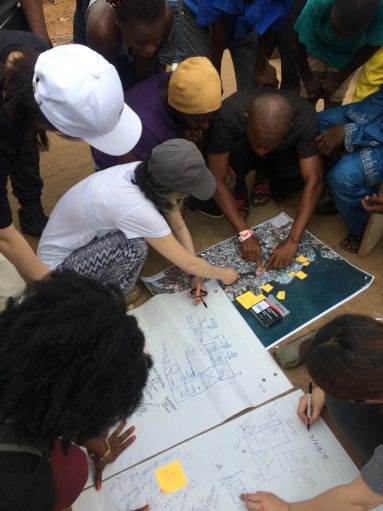Celebrating International Day of Persons with Disabilities in Sierra Leone and Indonesia
By Ignacia Ossul Vermehren, on 3 December 2020
By Ignacia Ossul Vermehren (DPU), Nina Asterina (Kota Kita) and Hawanatu Bangura (SLURC)
The 3rd of December is the International Day of Persons with Disabilities. We reflect on this year’s theme “Building Back Better: toward a disability-inclusive, accessible and sustainable post COVID-19 World” through DPU’s research “AT2030: Community led solutions” in informal settlements Sierra Leone and Indonesia.
While we know that 15% of the world’s population lives with a disability, there is no global data specifically on informal settlements. After conducting the rATA WHO survey last year, we found that 26% of people surveyed across four informal settlements in Indonesia and Sierra Leone experienced at least ‘some difficulty’ in seeing, walking, hearing, remembering and/or communicating. One third lacked the assistive products they needed. Despite being a major issue, disability tends to be overlooked in urban and development research.
The impact of COVID-19 on disabled people in informal settlements
Between April and August this year, we conducted a research on the impact of COVID-19 on older people and disabled residents in Sierra Leone and Indonesia. Distinct effects emerged, including loss of livelihoods, reduced educational opportunities, unequal access to government support, limited social life and poorer access to information. Moreover, COVID-19 recovery narratives emphasising the importance of ‘healthy bodies’ have exacerbated these difficulties and increased stigma towards disabled people (see video with stories from Indonesia here).
However, the research also highlighted how community-based organisations in the global South are stepping in to provide support, whether through life-saving resources, accessible information, new spaces for disabled people’s participation, or innovative collaborations in the city. As has been the case across the world, the pandemic has brought into focus the experiences of those more vulnerable members of the community.
Making disability visible in communities
While research in informal settlements has tended to overlook or co-opt the voices of disabled people, making disability more ‘visible’ has its tensions. A first step that challenges rather than reinforces stigma has been to engage with the specific lived experiences and priorities of disabled residents.
An important output of Phase 1 of the research has shown that the methods, implemented through grassroots organisations with a participatory approach in the communities, can facilitate an emerging collective and positive identity around ‘disability’. Many participants who did not initially want to refer to themselves as disabled, started to see disability as a more positive, political, group identity. Providing spaces for disabled residents to participate in the wider decision-making process of low-income communities, can further foster solidarity between disabled and non-disabled members of the community.
The leadership of the Federation of the Urban and Rural Poor (FEDURP) have themselves felt influenced in the way they approach disabled residents. As FEDURP’s country head said in a speech during last year’s Celebration of International Day of Persons with Disabilities: “We knew that disability was a big issue, but we hadn’t engaged with it, neither including disability in the discussion nor working with disabled residents specially. FEDURP is now committed to working with people with disabilities.”
Coming together to foster a political identity around disability
International Day of Persons with Disabilities has become an important event in giving visibility to disability in the two communities in Sierra Leone. This year, Sierra Leone Urban Research Centre, FEDURP and Dr. Abdulaya Dumbaya (a disability activist and Head of the Springer Trust Fund) will be reflecting on how COVID has affected disabled people, discussing disability rights and sharing stories of resilience in the communities.
In Pelambuan, a low-income neighbourhood in Banjarmasin, Indonesia, the celebrations this year led by NGO Kota Kita will be marked with the painting of a mural on the theme of “Community participation towards an inclusive neighbourhood (kampung)”. The mural aims to translate community voices and aspirations — particularly those with disabilities — and build collective identity through an inclusive approach.
As a physically impaired male participant in Pelambuan said, “I am really happy to participate in this mural project. I like the idea of turning our aspirations into images on the wall. I hope this activity can inspire other neighbourhoods to strengthen their community participation.”
Through making disability more visible, and engaging with tensions that may arise, the research has been able to create space for disabled people to take a shaping role in the community. Recognizing days such as this is an important step in continuing to do so.
The action research project “AT2030 Community Led Solutions” is led by DPU’s Julian Walker as part Global Disability Innovation Hub’s programme and funded by UK Aid.
 Close
Close
















